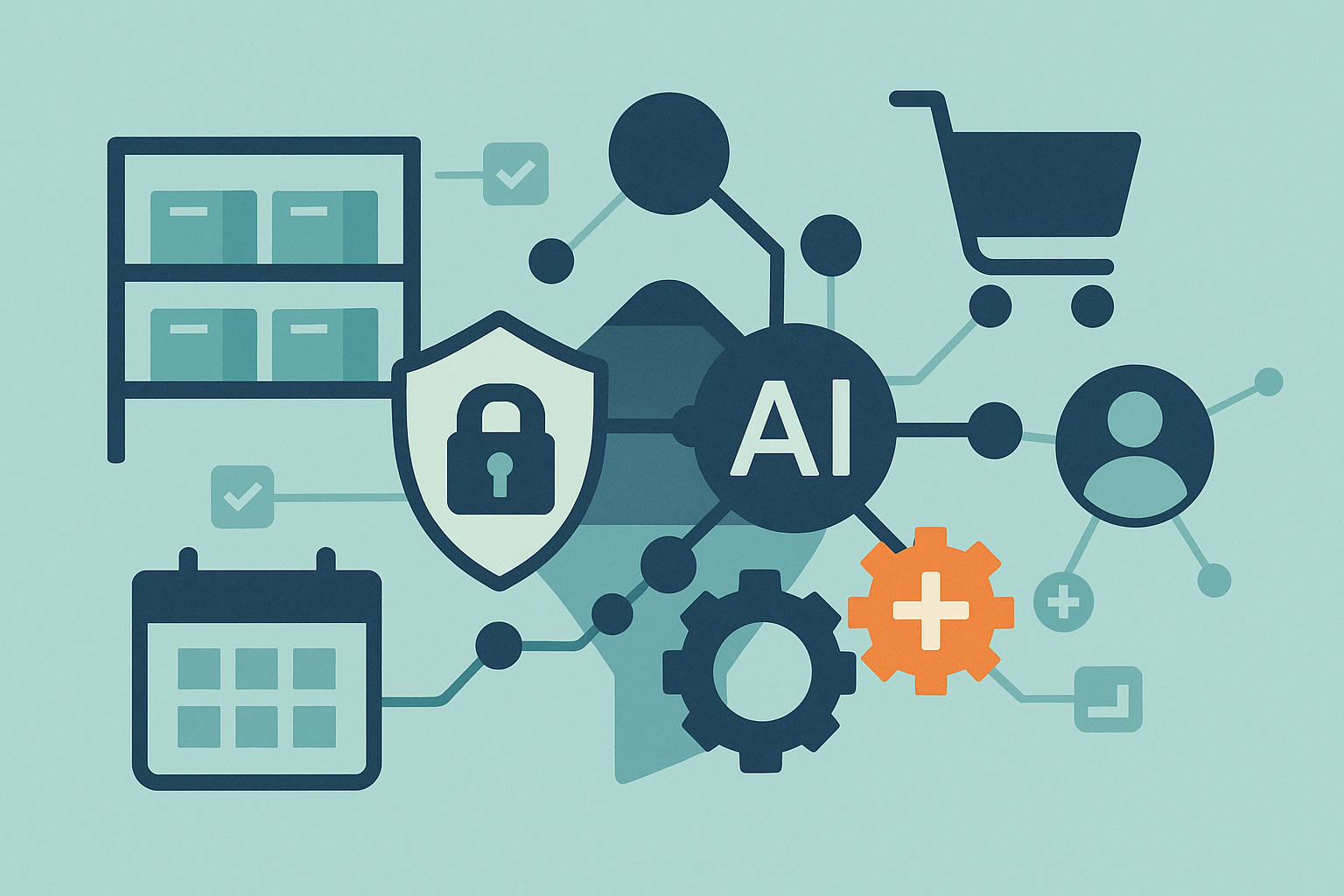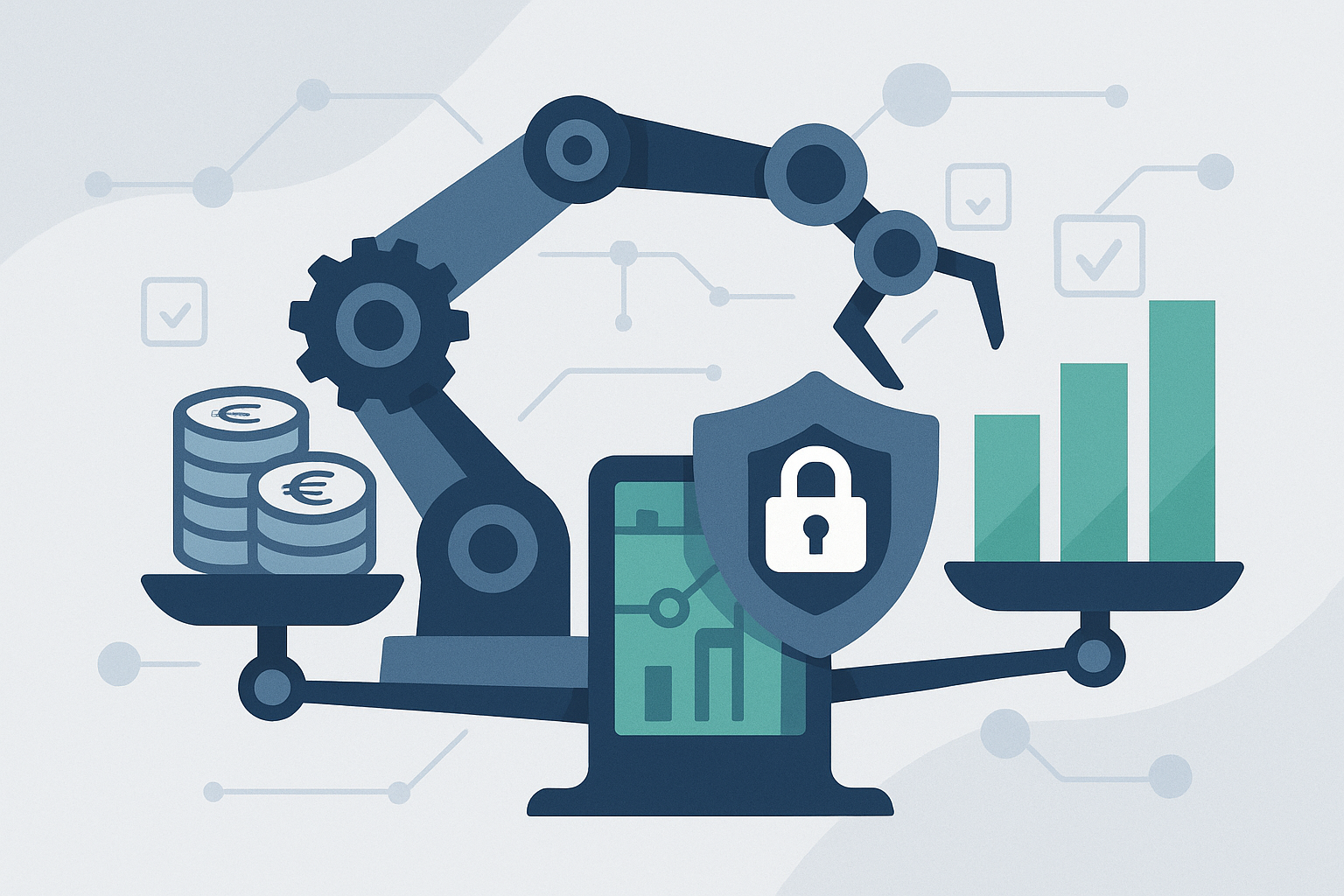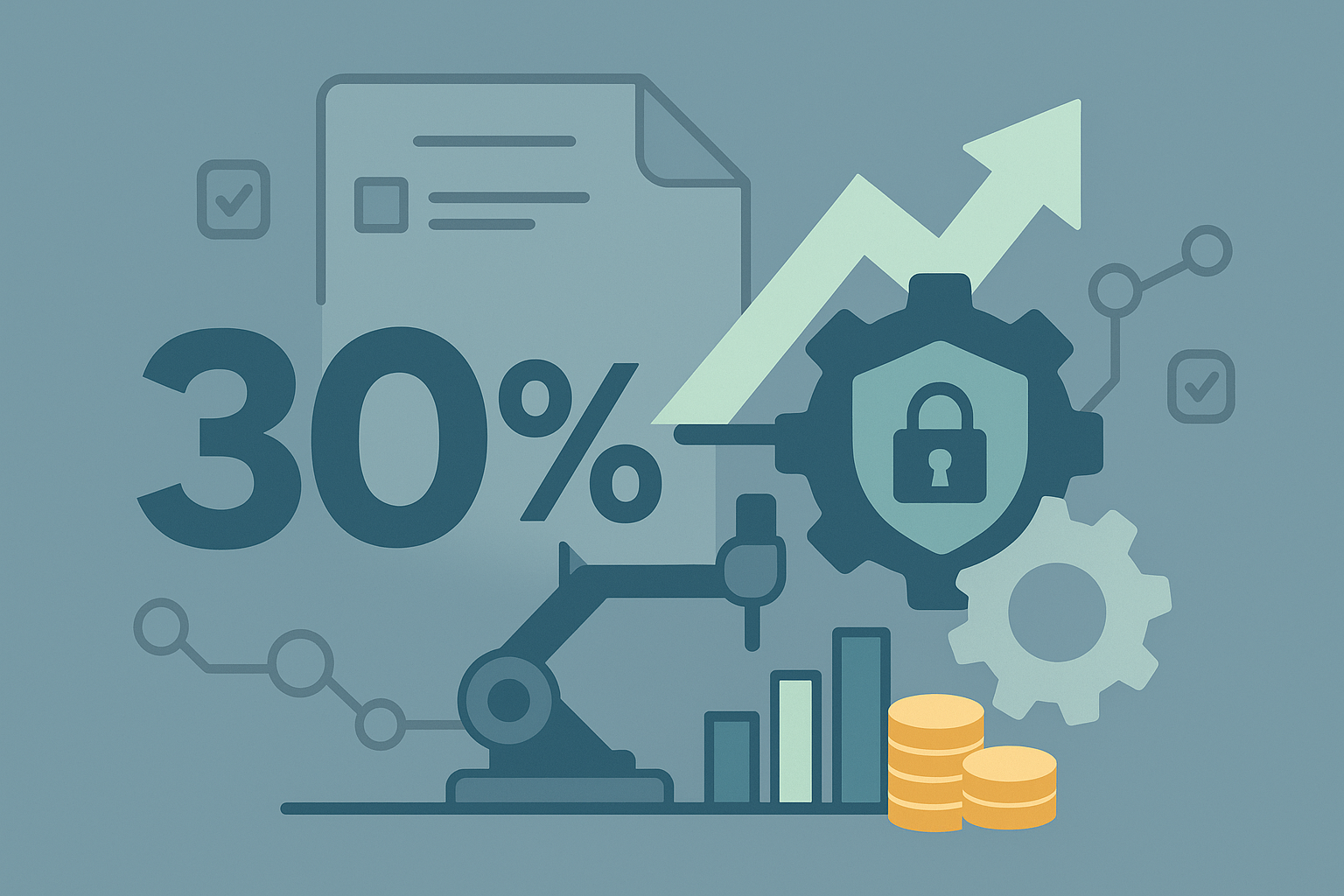KI-Content-Planung: Tools, Techniken und Best Practices
Revolutionieren Sie Ihre Content-Strategie mit KI: Von der Ideenfindung bis zur Distribution. Effiziente Tools und bewährte Methoden für bessere Inhalte.

KI-Content-Planung: Tools, Techniken und Best Practices
Künstliche Intelligenz revolutioniert die Content-Erstellung und -Planung. Während 87% der Marketer bereits KI-Tools nutzen, schöpfen die meisten nur einen Bruchteil des Potenzials aus. Dieser umfassende Leitfaden zeigt Ihnen, wie Sie KI strategisch für Content-Planung einsetzen – von der Ideenentwicklung bis zur Performance-Optimierung.
Die KI-Content-Revolution: Zahlen und Fakten
Aktuelle Marktentwicklung
- 73% der Unternehmen planen erhöhte KI-Investitionen im Content-Bereich
- 5x schnellere Content-Erstellung bei korrektem KI-Einsatz
- 40% höhere Engagement-Raten durch KI-optimierte Inhalte
- Kostensenkung um 60% bei der Content-Produktion
Deutsche Besonderheiten
Der deutsche Markt stellt spezielle Anforderungen:
- DSGVO-Konformität bei allen KI-Tools
- Hochwertige, tiefgreifende Inhalte werden bevorzugt
- Vertrauen in Marken ist entscheidend
- B2B-Fokus dominiert den Markt
Erfahren Sie mehr über DSGVO-konforme Marketing-Automatisierung für rechtssichere Content-Strategien.
Strategische KI-Content-Planung
1. KI-gestützte Content-Strategie Entwicklung
// KI-basierte Content-Strategie Framework
class AIContentStrategy {
constructor(businessData) {
this.businessData = businessData;
this.aiModels = {
trend_analysis: new TrendAnalysisAI(),
audience_insights: new AudienceAI(),
competitor_analysis: new CompetitorAI(),
content_optimization: new ContentOptimizationAI()
};
}
async developContentStrategy() {
const strategy = {
market_analysis: await this.analyzeMarket(),
audience_personas: await this.createAIPersonas(),
content_pillars: await this.identifyContentPillars(),
content_calendar: await this.generateContentCalendar(),
distribution_strategy: await this.optimizeDistribution(),
performance_framework: await this.setupPerformanceTracking()
};
return this.synthesizeStrategy(strategy);
}
async analyzeMarket() {
const trendData = await this.aiModels.trend_analysis.analyzeTrends({
industry: this.businessData.industry,
location: 'Germany',
timeframe: '12_months',
languages: ['de', 'en']
});
const competitorInsights = await this.aiModels.competitor_analysis.analyze({
competitors: this.businessData.competitors,
content_types: ['blog', 'social', 'video', 'podcasts'],
analysis_depth: 'comprehensive'
});
return {
trending_topics: trendData.trending_topics,
content_gaps: competitorInsights.content_gaps,
opportunity_score: this.calculateOpportunityScore(trendData, competitorInsights),
seasonal_patterns: trendData.seasonal_insights,
emerging_formats: trendData.format_trends
};
}
async createAIPersonas() {
const audienceData = await this.aiModels.audience_insights.analyzeAudience({
website_analytics: this.businessData.analytics,
social_insights: this.businessData.social_data,
customer_feedback: this.businessData.feedback,
market_research: this.businessData.research_data
});
const personas = await this.aiModels.audience_insights.generatePersonas({
audience_segments: audienceData.segments,
behavioral_patterns: audienceData.behaviors,
content_preferences: audienceData.preferences,
journey_stages: ['awareness', 'consideration', 'decision', 'retention'],
persona_count: 3 // Fokus auf 3 Haupt-Personas
});
return personas.map(persona => ({
name: persona.name,
demographics: persona.demographics,
pain_points: persona.pain_points,
content_preferences: persona.content_preferences,
preferred_channels: persona.channels,
decision_factors: persona.decision_criteria,
content_journey: persona.journey_mapping
}));
}
async identifyContentPillars() {
const businessGoals = this.businessData.goals;
const audienceNeeds = await this.getAudienceNeeds();
const industryTrends = await this.getIndustryTrends();
const pillars = await this.aiModels.content_optimization.generateContentPillars({
business_expertise: this.businessData.expertise_areas,
audience_interests: audienceNeeds,
industry_trends: industryTrends,
competitive_gaps: await this.getCompetitiveGaps(),
pillar_count: 4 // Optimal für deutsche B2B-Unternehmen
});
return pillars.map(pillar => ({
name: pillar.name,
description: pillar.description,
target_keywords: pillar.keywords,
content_types: pillar.formats,
frequency: pillar.publishing_frequency,
kpis: pillar.success_metrics,
content_examples: pillar.content_ideas
}));
}
}
2. Intelligente Content-Ideenfindung
KI-gestützte Themenrecherche:
// Content Idea Generator
class AIContentIdeaGenerator {
constructor(strategy, aiTools) {
this.strategy = strategy;
this.aiTools = aiTools;
this.ideaDatabase = new ContentIdeaDatabase();
}
async generateContentIdeas(timeframe = 'quarterly') {
const ideas = {
trending_topics: await this.analyzeTrendingTopics(),
seasonal_content: await this.generateSeasonalIdeas(),
evergreen_content: await this.createEvergreenIdeas(),
competitor_gap_analysis: await this.findCompetitorGaps(),
audience_questions: await this.harvestAudienceQuestions(),
industry_insights: await this.generateIndustryContent()
};
return this.prioritizeAndScheduleIdeas(ideas, timeframe);
}
async analyzeTrendingTopics() {
const trends = await this.aiTools.trend_analyzer.analyze({
industry: this.strategy.industry,
region: 'DACH',
timeframe: 'last_90_days',
include_emerging: true
});
const contentIdeas = [];
for (const trend of trends.trending_topics) {
const ideaVariations = await this.aiTools.content_generator.expandTopic({
main_topic: trend.topic,
trend_momentum: trend.momentum,
search_volume: trend.search_volume,
business_relevance: this.calculateBusinessRelevance(trend),
content_angles: [
'how_to_guide',
'industry_analysis',
'case_study',
'expert_interview',
'tool_comparison',
'best_practices'
]
});
contentIdeas.push({
category: 'trending',
main_topic: trend.topic,
variations: ideaVariations,
urgency_score: trend.momentum,
estimated_traffic: trend.search_volume,
competition_level: trend.competition,
content_gap_score: await this.calculateContentGap(trend.topic)
});
}
return contentIdeas;
}
async generateSeasonalIdeas() {
const seasonalCalendar = await this.aiTools.seasonal_analyzer.analyze({
industry: this.strategy.industry,
target_market: 'Germany',
include_holidays: true,
include_industry_events: true,
lookahead_months: 12
});
const seasonalContent = [];
for (const season of seasonalCalendar.seasons) {
const contentOpportunities = await this.aiTools.content_generator.generateSeasonalContent({
season: season.name,
key_dates: season.key_dates,
industry_events: season.industry_events,
historical_performance: season.historical_data,
content_types: ['blog_posts', 'social_campaigns', 'email_series', 'video_content']
});
seasonalContent.push({
season: season.name,
timeframe: season.timeframe,
content_opportunities: contentOpportunities,
preparation_timeline: season.preparation_timeline,
expected_performance: season.performance_prediction
});
}
return seasonalContent;
}
async harvestAudienceQuestions() {
const questionSources = {
support_tickets: await this.analyzeCustomerSupport(),
social_mentions: await this.analyzeSocialListening(),
search_queries: await this.analyzeSearchData(),
sales_feedback: await this.analyzeSalesFeedback(),
competitor_comments: await this.analyzeCompetitorEngagement()
};
const allQuestions = Object.values(questionSources).flat();
const clusteredQuestions = await this.aiTools.nlp_processor.clusterQuestions(allQuestions);
return clusteredQuestions.map(cluster => ({
topic_cluster: cluster.topic,
questions: cluster.questions,
question_volume: cluster.volume,
urgency_level: cluster.urgency,
content_format_suggestions: cluster.format_recommendations,
target_persona: cluster.primary_persona,
content_depth: cluster.complexity_level
}));
}
}
3. Content-Produktion mit KI
Strukturierte Content-Erstellung:
// AI Content Production Pipeline
class AIContentProducer {
constructor(contentStrategy) {
this.contentStrategy = contentStrategy;
this.aiWriters = {
blog_writer: new AIBlogWriter(),
social_writer: new AISocialWriter(),
email_writer: new AIEmailWriter(),
video_scripter: new AIVideoScripter()
};
this.qualityAssurance = new ContentQualityAI();
}
async produceContent(contentBrief) {
const productionPipeline = {
research_phase: await this.conductResearch(contentBrief),
outline_creation: await this.createOutline(contentBrief),
content_generation: await this.generateContent(contentBrief),
optimization: await this.optimizeContent(contentBrief),
quality_check: await this.performQualityCheck(contentBrief),
localization: await this.localizeContent(contentBrief)
};
return this.finalizeContent(productionPipeline);
}
async conductResearch(contentBrief) {
const research = {
primary_sources: await this.gatherPrimarySources(contentBrief.topic),
competitor_analysis: await this.analyzeCompetitorContent(contentBrief.topic),
expert_insights: await this.gatherExpertQuotes(contentBrief.topic),
statistical_data: await this.collectStatistics(contentBrief.topic),
case_studies: await this.findRelevantCaseStudies(contentBrief.topic)
};
const researchSynthesis = await this.aiWriters.blog_writer.synthesizeResearch({
raw_research: research,
content_angle: contentBrief.angle,
target_audience: contentBrief.target_persona,
content_goals: contentBrief.goals
});
return {
key_points: researchSynthesis.main_points,
supporting_data: researchSynthesis.supporting_evidence,
expert_quotes: researchSynthesis.expert_insights,
unique_angles: researchSynthesis.unique_perspectives,
content_gaps: researchSynthesis.competitive_gaps
};
}
async createOutline(contentBrief) {
const outlineStructure = await this.aiWriters.blog_writer.generateOutline({
topic: contentBrief.topic,
content_type: contentBrief.format,
target_length: contentBrief.target_word_count,
audience_level: contentBrief.audience_expertise,
content_goals: contentBrief.objectives,
seo_keywords: contentBrief.target_keywords,
brand_voice: this.contentStrategy.brand_voice
});
const enhancedOutline = {
title_options: outlineStructure.title_variations,
introduction: {
hook: outlineStructure.intro.hook,
problem_statement: outlineStructure.intro.problem,
value_proposition: outlineStructure.intro.value_prop,
preview: outlineStructure.intro.article_preview
},
main_sections: outlineStructure.sections.map(section => ({
heading: section.title,
key_points: section.main_points,
supporting_evidence: section.evidence,
practical_examples: section.examples,
call_to_action: section.cta_suggestion
})),
conclusion: {
key_takeaways: outlineStructure.conclusion.takeaways,
next_steps: outlineStructure.conclusion.action_items,
final_cta: outlineStructure.conclusion.main_cta
},
seo_optimization: {
title_tag: outlineStructure.seo.title_tag,
meta_description: outlineStructure.seo.meta_description,
keyword_placement: outlineStructure.seo.keyword_strategy,
internal_links: outlineStructure.seo.internal_link_opportunities
}
};
return enhancedOutline;
}
async generateContent(contentBrief, outline) {
const contentSections = [];
// Introduction Generation
const introduction = await this.aiWriters.blog_writer.writeIntroduction({
outline: outline.introduction,
brand_voice: this.contentStrategy.brand_voice,
hook_style: contentBrief.engagement_style,
target_persona: contentBrief.target_persona
});
contentSections.push({
type: 'introduction',
content: introduction.text,
engagement_score: introduction.engagement_prediction,
readability_score: introduction.readability_score
});
// Main Content Generation
for (const section of outline.main_sections) {
const sectionContent = await this.aiWriters.blog_writer.writeSection({
section_outline: section,
writing_style: this.contentStrategy.writing_style,
evidence_requirements: contentBrief.evidence_level,
example_preferences: contentBrief.example_style,
technical_depth: contentBrief.technical_level
});
contentSections.push({
type: 'main_section',
heading: section.heading,
content: sectionContent.text,
word_count: sectionContent.word_count,
readability_score: sectionContent.readability,
seo_score: sectionContent.seo_optimization
});
}
// Conclusion Generation
const conclusion = await this.aiWriters.blog_writer.writeConclusion({
outline: outline.conclusion,
main_points: contentSections.map(s => s.heading),
conversion_goal: contentBrief.conversion_objective,
next_step_priority: contentBrief.funnel_stage
});
contentSections.push({
type: 'conclusion',
content: conclusion.text,
cta_strength: conclusion.cta_effectiveness,
conversion_potential: conclusion.conversion_prediction
});
return {
sections: contentSections,
total_word_count: contentSections.reduce((sum, s) => sum + (s.word_count || 0), 0),
overall_quality_score: this.calculateQualityScore(contentSections),
seo_readiness: this.assessSEOReadiness(contentSections, outline.seo_optimization)
};
}
}
Content-Distribution mit KI optimieren
1. Multi-Channel-Distribution
Intelligente Kanalauswahl:
// AI Distribution Optimizer
class AIDistributionOptimizer {
constructor(audienceData, channelPerformance) {
this.audienceData = audienceData;
this.channelPerformance = channelPerformance;
this.distributionAI = new DistributionAI();
}
async optimizeDistribution(content) {
const distributionStrategy = {
channel_selection: await this.selectOptimalChannels(content),
timing_optimization: await this.optimizePublishingTiming(content),
format_adaptation: await this.adaptContentFormats(content),
audience_segmentation: await this.segmentAudienceForDistribution(content),
cross_promotion: await this.planCrossPromotion(content)
};
return this.executeDistributionPlan(distributionStrategy);
}
async selectOptimalChannels(content) {
const channelAnalysis = await this.distributionAI.analyzeChannels({
content_type: content.type,
target_audience: content.target_personas,
content_goals: content.objectives,
available_channels: this.getAvailableChannels(),
historical_performance: this.channelPerformance,
resource_constraints: this.getResourceLimitations()
});
const recommendedChannels = channelAnalysis.channels.map(channel => ({
channel: channel.name,
fit_score: channel.content_fit_score,
audience_overlap: channel.audience_match_percentage,
expected_reach: channel.predicted_reach,
engagement_prediction: channel.engagement_forecast,
resource_requirement: channel.effort_level,
roi_prediction: channel.roi_estimate,
optimal_format: channel.recommended_format
}));
return recommendedChannels.sort((a, b) => b.roi_prediction - a.roi_prediction);
}
async optimizePublishingTiming(content) {
const timingAnalysis = await this.distributionAI.analyzeTiming({
content_type: content.type,
target_channels: content.selected_channels,
audience_behavior: this.audienceData.online_behavior,
seasonal_factors: this.getSeasonalTrends(),
competitor_timing: this.getCompetitorTimingData(),
global_events: this.getGlobalEventCalendar()
});
return {
optimal_publish_time: timingAnalysis.best_time,
channel_specific_timing: timingAnalysis.channel_timing,
promotion_schedule: timingAnalysis.promotion_timeline,
republishing_opportunities: timingAnalysis.republish_windows,
seasonal_considerations: timingAnalysis.seasonal_adjustments
};
}
async adaptContentFormats(content) {
const formatAdaptations = {};
for (const channel of content.selected_channels) {
const adaptation = await this.distributionAI.adaptContent({
source_content: content.full_content,
target_channel: channel.name,
channel_requirements: channel.content_specs,
audience_preferences: channel.audience_preferences,
engagement_optimization: true
});
formatAdaptations[channel.name] = {
adapted_content: adaptation.content,
visual_elements: adaptation.visual_suggestions,
headline_variations: adaptation.headline_options,
cta_variations: adaptation.cta_options,
hashtag_suggestions: adaptation.hashtags,
engagement_hooks: adaptation.engagement_elements
};
}
return formatAdaptations;
}
}
2. Performance-Tracking und Optimierung
KI-gestützte Content-Analytics:
// Content Performance AI Analyzer
class ContentPerformanceAI {
constructor(analyticsData) {
this.analyticsData = analyticsData;
this.performanceAI = new PerformanceAnalysisAI();
}
async analyzeContentPerformance(contentPiece) {
const analysis = {
engagement_analysis: await this.analyzeEngagement(contentPiece),
conversion_analysis: await this.analyzeConversions(contentPiece),
seo_performance: await this.analyzeSEOMetrics(contentPiece),
social_performance: await this.analyzeSocialMetrics(contentPiece),
audience_insights: await this.analyzeAudienceBehavior(contentPiece),
competitive_benchmarking: await this.benchmarkAgainstCompetitors(contentPiece)
};
return this.generateOptimizationRecommendations(analysis);
}
async analyzeEngagement(contentPiece) {
const engagementData = await this.performanceAI.analyzeEngagement({
content_id: contentPiece.id,
metrics: ['time_on_page', 'scroll_depth', 'bounce_rate', 'comments', 'shares'],
timeframe: 'last_30_days',
segment_by: ['traffic_source', 'device_type', 'audience_segment']
});
const insights = {
overall_engagement_score: engagementData.engagement_score,
engagement_trends: engagementData.trends,
high_performing_sections: engagementData.top_sections,
engagement_dropoff_points: engagementData.dropoff_analysis,
audience_sentiment: engagementData.sentiment_analysis,
engagement_drivers: engagementData.success_factors
};
return insights;
}
async generateOptimizationRecommendations(analysis) {
const recommendations = await this.performanceAI.generateRecommendations({
performance_data: analysis,
optimization_goals: ['engagement', 'conversions', 'seo_ranking', 'social_reach'],
priority_level: 'high_impact',
resource_constraints: this.getResourceLimitations()
});
return {
immediate_actions: recommendations.quick_wins,
medium_term_improvements: recommendations.strategic_changes,
long_term_strategy: recommendations.strategic_shifts,
a_b_test_suggestions: recommendations.testing_opportunities,
content_refresh_opportunities: recommendations.refresh_candidates,
repurposing_suggestions: recommendations.repurposing_ideas
};
}
}
Praktische KI-Tools für Content-Teams
Top Content-KI-Tools 2024
Für deutsche Unternehmen empfohlene Tools:
-
Jasper AI (Enterprise)
- Stärken: Brand Voice Training, Team-Collaboration
- DSGVO: EU-Server verfügbar
- Kosten: €59-125/Monat
- Best für: Große Content-Teams
-
Claude AI (Anthropic)
- Stärken: Logisches Denken, lange Kontexte
- DSGVO: EU-Konform
- Kosten: €18-60/Monat
- Best für: Technische Inhalte
-
Copy.ai
- Stärken: Workflow-Automatisierung
- DSGVO: GDPR-konform
- Kosten: €36-186/Monat
- Best für: Marketing-Teams
-
Frase.io
- Stärken: SEO-Content-Optimierung
- DSGVO: EU-Server
- Kosten: €45-115/Monat
- Best für: SEO-fokussierte Teams
Integration mit bestehenden Workflows
n8n-Integration für Content-Automatisierung:
// n8n Workflow für Content-Pipeline
{
"name": "AI Content Production Pipeline",
"schedule": "0 9 * * 1", // Jeden Montag um 9 Uhr
"nodes": [
{
"name": "Content Idea Generation",
"type": "n8n-nodes-base.httpRequest",
"parameters": {
"url": "https://api.openai.com/v1/chat/completions",
"method": "POST",
"headers": {
"Authorization": "Bearer {{$vars.openai_api_key}}",
"Content-Type": "application/json"
},
"body": {
"model": "gpt-4",
"messages": [
{
"role": "user",
"content": "Generate 5 content ideas for German B2B automation industry based on current trends"
}
]
}
}
},
{
"name": "Content Brief Creation",
"type": "n8n-nodes-base.function",
"parameters": {
"functionCode": `
const ideas = items[0].json.choices[0].message.content;
const contentBriefs = [];
// Parse AI-generated ideas and create content briefs
const ideaList = ideas.split('\\n').filter(line => line.trim().length > 0);
ideaList.forEach((idea, index) => {
contentBriefs.push({
id: Date.now() + index,
title: idea.replace(/^\\d+\\.\\s*/, ''),
target_audience: 'German B2B decision makers',
content_type: 'blog_post',
target_length: 2000,
seo_focus: true,
deadline: new Date(Date.now() + 7*24*60*60*1000).toISOString(),
status: 'ready_for_research'
});
});
return contentBriefs.map(brief => ({ json: brief }));
`
}
},
{
"name": "Research Automation",
"type": "n8n-nodes-base.httpRequest",
"parameters": {
"url": "https://api.perplexity.ai/chat/completions",
"method": "POST",
"authentication": "headerAuth"
}
},
{
"name": "Content Calendar Update",
"type": "n8n-nodes-base.notion",
"parameters": {
"operation": "create",
"resource": "databasePage"
}
}
]
}
Entdecken Sie mehr über n8n-Automatisierung für Content-Workflows.
ROI-Messung für KI-Content-Strategien
Content-Performance-Metriken
Messbare KPIs für KI-Content:
Content Efficiency Metrics:
Production Speed:
- Ideas zu Content: -70% Zeit
- Research zu Draft: -60% Zeit
- Revision Cycles: -50% Zeit
Quality Metrics:
- Content Engagement: +40%
- SEO Performance: +35%
- Conversion Rate: +25%
- Brand Consistency: +90%
Cost Efficiency:
- Cost per Content Piece: -55%
- Content Team Productivity: +200%
- Time to Market: -65%
- Overall Content ROI: +180%
German Market Specific:
DSGVO Compliance: 100%
German Language Quality: Native-level
Local Market Relevance: +85%
B2B Decision Maker Engagement: +60%
Business Impact Berechnung
ROI-Framework für Content-KI:
// Content AI ROI Calculator
class ContentAIROICalculator {
constructor(baselineMetrics, investmentCosts) {
this.baseline = baselineMetrics;
this.investment = investmentCosts;
}
calculateContentROI(timeframe = 12) {
const benefits = {
time_savings: this.calculateTimeSavings(),
quality_improvements: this.calculateQualityGains(),
scale_benefits: this.calculateScaleAdvantages(),
opportunity_costs: this.calculateOpportunityCosts()
};
const costs = {
tool_licenses: this.investment.ai_tools_monthly * timeframe,
training_costs: this.investment.team_training,
integration_costs: this.investment.system_integration,
ongoing_optimization: this.investment.monthly_optimization * timeframe
};
const roi = {
total_benefits: Object.values(benefits).reduce((sum, benefit) => sum + benefit, 0),
total_costs: Object.values(costs).reduce((sum, cost) => sum + cost, 0),
net_benefit: 0,
roi_percentage: 0,
payback_months: 0
};
roi.net_benefit = roi.total_benefits - roi.total_costs;
roi.roi_percentage = (roi.net_benefit / roi.total_costs) * 100;
roi.payback_months = roi.total_costs / (roi.total_benefits / timeframe);
return roi;
}
calculateTimeSavings() {
const hourlyRate = 75; // € Durchschnittlicher Content-Marketer Stundensatz
const hoursPerMonth = this.baseline.content_pieces_per_month *
this.baseline.hours_per_content_piece;
const efficiencyGain = 0.6; // 60% Zeitersparnis
return hoursPerMonth * efficiencyGain * hourlyRate * 12; // Jährliche Einsparung
}
calculateQualityGains() {
const baselineConversion = this.baseline.content_conversion_rate;
const improvedConversion = baselineConversion * 1.25; // 25% Steigerung
const monthlyTraffic = this.baseline.monthly_content_traffic;
const conversionValue = this.baseline.average_conversion_value;
const additionalConversions = monthlyTraffic *
(improvedConversion - baselineConversion);
return additionalConversions * conversionValue * 12; // Jährlicher Mehrwert
}
}
Key Takeaways: KI-Content-Planung meistern
Die wichtigsten Erkenntnisse für erfolgreiche KI-Content-Strategien:
- 87% der Marketer nutzen bereits KI-Tools, aber nur 23% schöpfen das volle Potenzial aus
- 5x schnellere Content-Produktion bei strategischem KI-Einsatz möglich
- DSGVO-Konformität ist kritisch für deutsche Unternehmen - EU-Server bevorzugen
- 40% höhere Engagement-Raten durch KI-optimierte Content-Strategien
- ROI von 180%+ nach 12 Monaten bei professioneller Implementierung
- Kontinuierliche Optimierung durch Performance-AI erhöht Effektivität um 25%
Häufig gestellte Fragen (FAQ)
Q: Wie stelle ich sicher, dass KI-generierter Content authentisch bleibt? A: Entwickeln Sie einen klaren Brand Voice Guide und trainieren Sie KI-Tools darauf. Verwenden Sie KI für Struktur und Research, aber fügen Sie immer persönliche Expertise und Beispiele hinzu. 70% KI-Effizienz + 30% menschliche Authentizität ist die optimale Balance.
Q: Welche KI-Tools sind DSGVO-konform für deutsche Unternehmen? A: Claude AI, Jasper AI (EU-Server), Copy.ai (GDPR-Version) und Frase.io bieten EU-Server. Prüfen Sie immer die Datenschutzerklärung und wählen Sie Tools mit expliziter DSGVO-Compliance. Mehr über DSGVO-Marketing.
Q: Wie messe ich den ROI meiner Content-KI-Investition? A: Tracken Sie Zeitersparnis (60-70% typisch), Qualitätsverbesserungen (Engagement +40%), und Skalierungseffekte. Der durchschnittliche ROI liegt bei 150-200% nach 12 Monaten. Berechnen Sie Ihr Potenzial.
Q: Kann KI komplexe B2B-Inhalte für deutsche Märkte erstellen? A: Ja, moderne KI-Tools können technische B2B-Inhalte erstellen, benötigen aber fachliche Expertise als Input. KI übernimmt Research, Struktur und Formulierung - Experten fügen Tiefe und Branchenspezifika hinzu.
Q: Wie integriere ich KI-Content-Tools in bestehende Workflows? A: Starten Sie mit einem Tool für einen spezifischen Use Case (z.B. Blog-Ideen). Nutzen Sie n8n-Workflows für Automatisierung. Schulen Sie das Team schrittweise und dokumentieren Sie Best Practices.
Q: Welche Content-Formate eignen sich am besten für KI-Unterstützung? A: Blog-Posts, Social Media Content, E-Mail-Kampagnen und Produktbeschreibungen zeigen die besten Ergebnisse. Video-Scripts und Webinar-Inhalte funktionieren auch gut. Komplexe Whitepaper benötigen mehr menschliche Expertise.
Bereit für KI-gestützte Content-Exzellenz? Unsere Content-KI-Experten entwickeln maßgeschneiderte Strategien für maximale Content-Performance. Buchen Sie eine kostenlose Content-KI-Beratung oder ermitteln Sie Ihr Optimierungspotenzial mit unserem Content-ROI-Rechner.
Nächste Schritte:
- Kostenlose Content-KI-Strategie-Session buchen für Ihr Unternehmen
- Content-ROI-Potenzial berechnen mit unserem Tool
- DSGVO-konforme Marketing-Automatisierung für rechtssichere Umsetzung
- Workshop für hands-on Content-KI-Implementation vereinbaren


